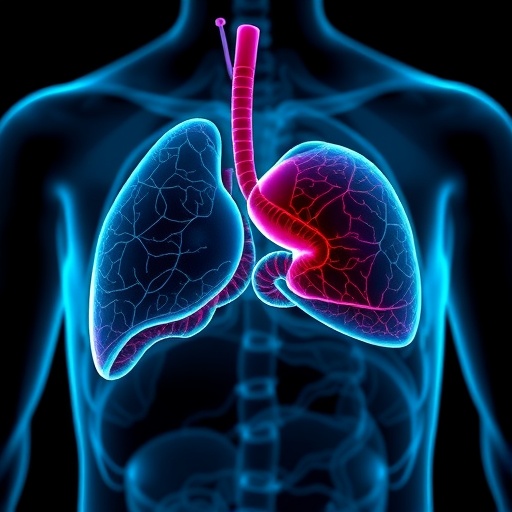In a groundbreaking study published in the Journal of Translational Medicine, researchers have unveiled the remarkable therapeutic potential of betulinic acid as a novel inhibitor of the angiotensin II type 1 receptor (AT1R), targeting a critical pathway involved in the progression of liver fibrosis. Chronic hepatic injury remains a pressing health issue globally, often leading to irreversible liver damage and increasing the risk of cirrhosis and liver cancer. This study by Zhu et al. presents an innovative approach for mitigating liver fibrosis, highlighting the intricate interplay between endothelial and mesenchymal cells and their role in the fibrotic process.
The significance of targeting AT1R lies in its pivotal role in the renin-angiotensin system (RAS), which regulates blood pressure and fluid balance but is also implicated in fibrotic diseases. Angiotensin II, the primary effector of this system, exacerbates fibrosis through its actions on various tissues, including the liver. By focusing on the AT1R, researchers aim to disrupt this pathological mechanism while promoting healthier liver function.
Betulinic acid, a naturally occurring pentacyclic triterpene found in the bark of birch trees, has previously shown promise in various therapeutic contexts, including cancer and neuroprotection. Its anti-inflammatory and anti-fibrotic properties have prompted researchers to explore its role as an AT1R inhibitor. The current study meticulously examines how betulinic acid functions at a cellular level, leading to significant attenuation of liver fibrosis and the modulation of the endothelial–mesenchymal transition (EndMT).
EndMT is a biological process through which endothelial cells lose their characteristics and acquire a mesenchymal phenotype, contributing to fibrosis and scarring in damaged organs. This transition is accentuated in chronic liver diseases, leading to the accumulation of extracellular matrix components and, ultimately, liver dysfunction. Zhu and colleagues demonstrated that administration of betulinic acid significantly inhibited this transition, suggesting it may interrupt the fibrogenic cascade at a critical juncture.
Utilizing advanced in vitro and in vivo models, the researchers illustrated how betulinic acid achieves these effects. In vitro cell culture studies revealed that betulinic acid treatment reduced the expression of key mesenchymal markers and decreased the production of fibrogenic mediators. These findings were corroborated in vivo using an experimental liver fibrosis model, where betulinic acid treatment led to a marked reduction in fibrous tissue deposition.
Furthermore, the study delved into the molecular mechanisms underpinning these observations. The authors reported that betulinic acid effectively downregulated the expression of specific signaling pathways activated by angiotensin II, indicating a direct relationship between AT1R inhibition and the observed anti-fibrotic effects. This molecular insight is crucial for developing therapeutic strategies and highlights the importance of the AT1R as a target for liver fibrosis.
Importantly, the safety profile of betulinic acid was also a focal point of this research. The study extensively evaluated potential toxic effects through comprehensive analyses, which confirmed that the compound exhibited low toxicity, thereby reinforcing its candidacy as a therapeutic agent. Stakeholders in the field of hepatology were particularly excited about these findings, as they point towards a promising new avenue for treatment options for patients suffering from various forms of liver disease.
As researchers continue to unveil the full spectrum of betulinic acid’s biological effects, the implications extend beyond liver health. The potential to repurpose existing natural compounds for new therapeutic applications underscores a vital trend in modern medicine: the search for effective treatments in chronic diseases that traditionally rely on synthetic drugs. With the mounting evidence surrounding the benefits of betulinic acid, there is growing interest in further investigating its role in other fibrotic conditions across different organ systems.
With fibrosis as a common endpoint for many chronic diseases, the relevance of this study resonates with a broader audience beyond just liver specialists. The findings could spearhead interest in research on similar compounds, fostering a wave of innovation in approaches to tackle sclerosis in various tissues, from lungs to kidneys. Notably, the collaboration of multiple research entities on this project exemplifies how interdisciplinary approaches enhance scientific discoveries, ultimately accelerating the translation of findings from bench to bedside.
In conclusion, this pivotal study sheds light on betulinic acid’s dual functionality as both an AT1R inhibitor and an agent capable of disrupting the endothelial-mesenchymal transition pathway. As we move towards a better understanding of complex chronic diseases, such natural compounds could provide key insights into the establishment of effective treatment paradigms for liver disease and potentially other fibrotic conditions. The work of Zhu, Dai, Liu, and their team not only expands our knowledge of liver fibrosis pathophysiology but also offers hope for innovative therapeutic alternatives that could improve patient outcomes in the future.
The door has been opened for further studies that may enhance our understanding of the underlying mechanisms of liver fibrosis and the broader implications of AT1R inhibition. With more research, betulinic acid might become a cornerstone in the evolving landscape of antifibrotic therapy. Its natural origin, combined with a favorable safety profile, could position it as a frontrunner in developing sustainable therapeutic interventions against chronic liver diseases in our quest to conquer these silent yet formidable foes.
Subject of Research: Liver fibrosis and AT1R inhibition via betulinic acid.
Article Title: Betulinic acid as a novel AT1R inhibitor: attenuation of liver fibrosis via modulation of endothelial–mesenchymal transition in chronic hepatic injury.
Article References:
Zhu, B., Dai, X., Liu, C. et al. Betulinic acid as a novel AT1R inhibitor: attenuation of liver fibrosis via modulation of endothelial–mesenchymal transition in chronic hepatic injury.
J Transl Med 23, 1282 (2025). https://doi.org/10.1186/s12967-025-07362-w
Image Credits: AI Generated
DOI: https://doi.org/10.1186/s12967-025-07362-w
Keywords: Betulinic acid, AT1R inhibitor, liver fibrosis, endothelial-mesenchymal transition, chronic hepatic injury.




